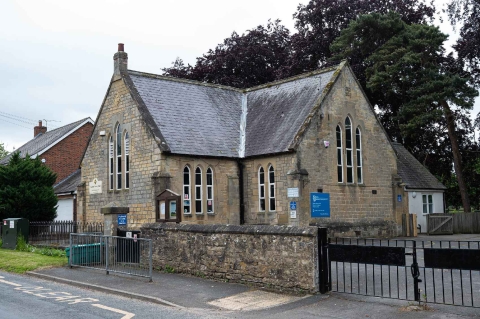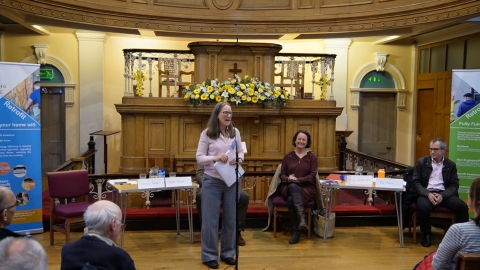Devolution for York and North Yorkshire and Unitarisation for North Yorkshire
Following the invitation from government for proposals to address the 2-tier county and district local authority structures and so, unlock the devolution process, City of York Council today (16 October) proposed there is no functional, historical or logical reason to merge York with surrounding rural and coastal areas.
See invitation letter from central government
In a report to the Executive, it is proposed that York’s footprint should remain the same, to retain local decision making in York, focus on recovery efforts, avoid significant disruption and cost, and continue to deliver value for money services to residents, businesses and communities.
If agreed, Executive will refer to Full Council on 29 October to decide whether to provide a submission to government that demonstrates York should remain on the existing footprint by providing evidence that there is no functional, historical or logical reason to merge York with other local authorities.
To reduce the 2-tier county and district structures in North Yorkshire, there are only two options being put forward. The first, the council’s preferred option, would mean York remains on its existing footprint and North Yorkshire creates a new single council, serving the whole of North Yorkshire and based on its recognised geography and identity. This would bring together the eight councils currently providing public services there. The second, proposed by the district authorities, is an east/west split that would see York merge with Ryedale, Scarborough and Selby, covering a geography that would stretch 65 miles north/south, and 45 miles east/west.
To achieve greater efficiencies between City of York Council and North Yorkshire County Council, a Strategic Partnership agreement has been created, which describes how seizing opportunities to share resources or lead different aspects of service delivery, whilst respecting the differences between the two places, will better support the region.
There are several benefits of York remaining as a unitary on its existing footprint:
- The speed at which devolution maybe achieved
- The continuity of services at a time critical for Covid recovery
- The continued identify of the City
However, should any change be made to City of York’s existing footprint, there will be a series of detrimental impacts, including
- an anticipated £117 increase for Band D taxpayers in York (representing an 8% increase).
- disruption to services across York and the districts during this crucial recovery period
- end of the 800 year connection between the city and the council, impacting on the very identity of the city.
Over the past few months, consultation has taken place with local residents, businesses and communities regarding devolution and unitarisation, which has been used to feed into the analysis of proposals included in the report. As part of Our Big Conversation, residents have been sending their views on the topic, with 65% of residents believing council services won’t be improved by covering a larger area. As part of the consultation, the Council has also held two devolution focused Facebook Live Q&A’s, and has set up numerous briefing sessions with local businesses, charitable and voluntary groups, and local civic organisations.
The council has not been consulted on the east/west proposal and therefore does not know the detail. As a result it is not possible to accurately assess the impact.
York has a strong case for remaining the same:
- It is a median-sized unitary authority with the 7th lowest level of council tax of any unitary.
- It’s geography (compact urban and sub-urban) is distinctly different to it’s surrounding area (rural and coastal)
- It has maintained financial stability since it was formed in 1996.
- It supports a successful, sustainable city, recognised as one of the best places to live in the UK, with world renowned universities and an education system amongst the best in the country.
York responds to the criteria set by central government
To support Executive make an informed decision, the council has summarised evidence for its case to continue on its existing footprint against the criteria provided by government.
The government asked for evidence that shows how any proposal would:
|
||
| York | Merged York | |
| Service delivery | Good – strong performance in key areas based on compact urban or sub-urban areas.
It was the 12th fastest out of 314 authorities to distribute business grants during covid19. The schools system supports the highest skills level of any northern city. |
New services spread over a larger more diverse geography which is unlikely to be efficient and therefore unlikely to be improved for York residents.
High performing services, especially in adult and children services supporting the most vulnerable would end and need to be recreated – leading to significant disruption. |
| Value for money | Low spend, in the bottom quartile of all unitary authorities – services cost on average £265 less per dwelling per year than surrounding areas. | Although potential efficiencies in reducing duplication, unlikely to directly apply to York which has already made greater efficiencies |
| Stronger leadership | By remaining the same, leadership would remain, with opportunity to quickly establish the combined authority and an elected mayor, strengthening regional leadership. | Unknown |
| Sustainable structures | Established in 1996 and not experienced financial challenges of other local authorities. York has successful secured investment for major projects including £77.1m for York Central.
A single North Yorkshire unitary would create financial efficiencies to enhance York’s existing sustainability. |
Unknown – risks instability due to attempting to harmonise council tax.
Unknown- ability to attract investment into an unrecognised geography. |
|
||
| York | Merged York | |
| Cost to tax payer | 7th lowest council tax of any unitary authority, significantly lower than neighbouring authorities | York residents would pay an additional £117 each year for a Band D property compared to retaining the existing council structure. This increase of over 8% would effectively subsidise the areas in Selby, Ryedale and Scarborough at the expense of York residents |
| Disruption | None | Significant, particularly in Children and Adults which would be split in half from previous arrangements with new models required to serve different and diverse geography. |
| Residents told us… (source: (1) Talk York / (2) Our Big Conversation consultation ) | (1) Over 5,000 people confirm that York’s key strength is it’s size with all the benefits of city living whilst remaining at a human scale. | (2) 65% residents believe council services won’t be improved by covering a larger area
74% oppose to paying more council tax to cover the costs |
| Stakeholders told us… | Broad support – representations made to continue the same from health, education and business | |
|
||
| York | Merged York | |
| Scale | York is the median average size for existing unitary councils. It is the optimum size for the city it serves – understands and works with businesses and local communities | Would stretch 65 miles north/south and 45 miles east/west |
| Geography | 105 sq miles, densely populated (7.7 people per hectare) – classified as urban with city and town.
The economic geography relates to West Yorkshire, represented through the non-constituent membership of West Yorkshire Combined Authorities. Commuting and economic links with west Yorkshire are well defined, unlike in rural or coastal areas. |
At c3,000 sq miles, neither a logical, functional nor historical footprint |
| Identity | Independent and self-governing since 1212.
Internationally recognised. The chain of York Lord Mayors and chair of York council, dating back to 1217, would break as the Lord Mayor would no longer represent York. |
No identity – a new corporate brand could be developed however given the disparate geography it is unlikely to support the same sense of belonging or civic pride that York residents have for York. |
Responding to the summary evidence, Cllr Keith Aspden, Leader of City of York Council said:
Any devolution deal must be right for York and be of direct benefit to our residents, communities, and businesses. Any change to City of York Council in order to include surrounding rural and coastal areas would either increase the cost to residents, or stretch services further, thus making it harder to meet York’s own unique challenges.
Following consultation, we believe proposals that cause as little disruption as possible to allow City of York Council to concentrate on recovery at this critical time is the right way forward. For this reason, the best way to support strong recovery, secure devolution quickly, and support the Levelling-Up agenda in York and North Yorkshire, is with City of York continuing as a unitary authority. Any other model of local government would fail to effectively represent York’s history, communities and the unique characteristics of the city.”
York’s unique character, beautiful heritage and strong history is recognised across the world. Protecting our identity, whilst keeping costs low and minimising service disruption for our residents, is of paramount importance for our future long term prosperity. Ultimately, any decision that affects York’s residents, businesses and communities, should be made in York.
Cllr Andy D’Agorne, Deputy Leader of City of York Council, added:
I would like to thank all the residents and partners who responded to Our Big Consultation about unitarisation and devolution. Your feedback has helped inform our approach and provided clarity about what’s important to you.”
Progressing devolution will help York and North Yorkshire become England’s first carbon negative economy, with significant investment in low-carbon technologies and in our transport infrastructure.
However, there is no functional, historical or logical reason for merging York with any other local authority. Not only would it lead to significant disruption, it would create huge costs that would lead to increases in council tax and financial instability.
To progress devolution, we need to work with North Yorkshire County Council to make sure what’s right for them is right for York and of direct benefit to our residents, communities and businesses.
Cllr Carl Les, Leader of North Yorkshire County Council said:
We have been very clear from the beginning that we believe a new single council, bringing together the best of the county and seven district councils, presents the best possible opportunity for everyone in North Yorkshire. In preparing our proposal for government, we have and continue, to listen very carefully to a broad range of partners, groups, organisations, individuals and businesses over many weeks.
We believe it is crucial to retain the identity of North Yorkshire and to offer every single person here the best possible chances in life and the same high quality services and support, regardless of where they live in the county.
Our proposal also protects the unique identity of the City of York, which is already served by an established unitary council.
By formalising our intent to work even more closely with the city, via a York and North Yorkshire Strategic Partnership, we will ensure that the value of every public pound is maximised, that crucial and nationally acclaimed services are protected and strengthened, and that innovations can be shared and implemented to benefit all.
“It will also give us the strongest possible voice to lobby for investment here and reflects the already well established and recognised alliance in place via the local enterprise partnership and the local resilience forum – both of which service the city and county already.
Professor Stephen Eames CBE Independent Chair and Lead for the Humber Coast & Vale Partnership, Phil Mettam Accountable Officer, Vale of York Clinical Commissioning Group and Simon Morritt Chief Executive, York Teaching Hospital NHS Foundation Trust said:
We would be very concerned if any shake up of local government disrupts or fragments partnership arrangements and distracts us from the continuing challenge of dealing with COVID and its aftermath and restoring services to normal levels across health and social care. In fact we would regard the retention of City of York Council as a requirement for the alignment and streamlining we need in order to more readily break down boundaries between health and care and simplify joined up working.
The Council already work collaboratively and effectively with key partners inside and outside the city – neighbouring councils, the business community, the NHS, the Local Enterprise Partnership (LEP), Voluntary and Community sector and a wide range of other bodies and organisations that make up the complex organisational and structural fabric that supports the well-being of the city, its residents and businesses. The very close, dynamic and effective working relationship with the York and North Yorkshire LEP reflects the importance of York to the wider economy across North Yorkshire and the interdependence that brings. They are able to focus on York as a distinctly different type of place whilst being an integral asset at the regional level.
Building further on this collaboration, with a new unitary authority for North Yorkshire, provides the economies of scale whilst maintaining focus and identify for the distinctly different geographies of the area.
Andrew Digwood, Chair of York Chamber of Commerce said:
The Chamber considers that being able to progress towards a devolution deal quickly and with a minimum of disruption to services is essential for York & North Yorkshire, as is the ability to for the underlying structure of any devolution deal to be able to both deliver benefits at scale and recognise and play to the strengths of the both the city of York and the wider North Yorkshire county. The potential prizes of devolution for the city and the region are considerable.
As a city, York has an identity that is recognised worldwide, is home to some world-leading businesses in fields as diverse as confectionery, rail technology and digital media, as well as to two highly regarded universities and two successful further education colleges.
It is one of the most recognisable and most visited cities not only in the UK but around the world, with a 2000 year history and plans for a bright and innovation-led future. York’s proportionate contribution to the proposed devolved region economically and in terms of its distinct identity, strengths and potential cannot be overstated, and for that reason the Chamber supports the opportunity to retain that distinct identity within the devolution and unitarisation proposal.






